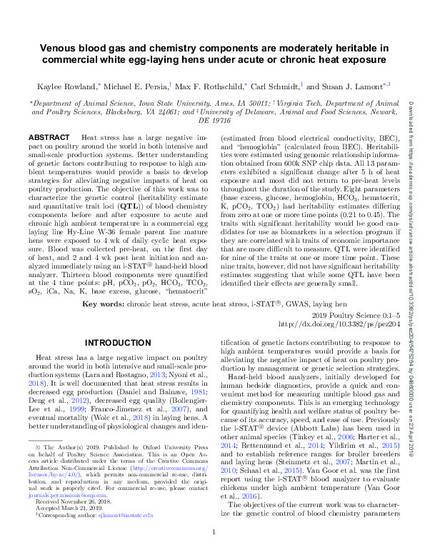
Heat stress has a large negative impact on poultry around the world in both intensive and small-scale production systems. Better understanding of genetic factors contributing to response to high ambient temperatures would provide a basis to develop strategies for alleviating negative impacts of heat on poultry production. The objective of this work was to characterize the genetic control (heritability estimate and quantitative trait loci (QTL)) of blood chemistry components before and after exposure to acute and chronic high ambient temperature in a commercial egg laying line Hy-Line W-36 female parent line mature hens were exposed to 4 wk of daily cyclic heat exposure. Blood was collected pre-heat, on the first day of heat, and 2 and 4 wk post heat initiation and analyzed immediately using an i-STAT® hand-held blood analyzer. Thirteen blood components were quantified at the 4 time points: pH, pCO2, pO2, HCO3, TCO2, sO2, iCa, Na, K, base excess, glucose, “hematocrit” (estimated from blood electrical conductivity, BEC), and “hemoglobin” (calculated from BEC). Heritabilities were estimated using genomic relationship information obtained from 600k SNP chip data. All 13 parameters exhibited a significant change after 5 h of heat exposure and most did not return to pre-heat levels throughout the duration of the study. Eight parameters (base excess, glucose, hemoglobin, HCO3, hematocrit, K, pCO2, TCO2) had heritability estimates differing from zero at one or more time points (0.21 to 0.45). The traits with significant heritability would be good candidates for use as biomarkers in a selection program if they are correlated with traits of economic importance that are more difficult to measure. QTL were identified for nine of the traits at one or more time point. These nine traits, however, did not have significant heritability estimates suggesting that while some QTL have been identified their effects are generally small.
Available at: http://works.bepress.com/max-rothschild/266/

This article is published as Rowland, Kaylee, Michael E. Persia, Max F. Rothschild, Carl Schmidt, and Susan J. Lamont. "Venous blood gas and chemistry components are moderately heritable in commercial white egg-laying hens under acute or chronic heat exposure." Poultry Science (2019). doi: 10.3382/ps/pez204.